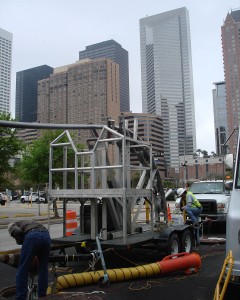April 2013, Vol. 68 No. 4
New Products
New Technology Leads To Successful Electric Transmission Project

Since the first building in Houston, TX, was air conditioned in 1923, media has often dubbed the city, “the air conditioning capital of the world.” With summer temperatures often exceeding 100 degrees Fahrenheit, it’s no wonder that Houstonians are concerned about reliable electricity to keep the units running.
Houston’s population of 2.3 million makes it the fourth most populous city in the U.S. and the largest in Texas. Downtown Houston, the city’s central business district, hosts the headquarters of many prominent companies. It is also home to Minute Maid Park, Toyota Center, George R. Brown Convention Center and a 17-block theater district just to name a few of its attractions.
CenterPoint Energy’s electric transmission and distribution unit serves more than 2.1 million customers in a 5,000 square-mile area that includes Houston. With over 3,700 miles of transmission lines, 47,000 miles of distribution lines and 232 substations, CenterPoint Energy delivers electricity on behalf of 79 retail electric providers.

One of the underground transmission circuits serving the downtown Houston area is the 2.3 mile 138 kV Garrott to Midtown to Polk circuit. Its rating for continuous operation is 247 Mega Volt Amperes (MVA). CenterPoint Energy recommended upgrading the underground circuit by installing a new cable parallel with the existing one to increase the capacity of the circuit to a continuous rating of approximately 498 MVA. The existing line was a high-pressure fluid-filled (HPFF) pipe-type underground transmission system. After researching options, the engineers decided to parallel bundle the HPFF system with an extruded cross-linked polyethylene underground cable system.
The existing 138 kV transmission line is located in an urban environment so installation of the new parallel line left no option other than trenchless methods. The project was awarded to Boyer Inc. of Houston. They chose to build the new line with centrifugally cast, fiberglass reinforced, polymer mortar (CCFRPM) pipe.
Conduit
Hobas Pipe USA supplied 7,000 feet of 30-inch, 230-ton jacking pipe to be used as casing for the conduit. Hobas pipe was selected for its capability to be jacked long distances and its non-metallic properties stood out. “Non-metallic Hobas pipe is manufactured of thermosetting resins which retain their properties better than thermoplastics when exposed to elevated temperatures,” explained Rene Garcia, engineering supervisor, Hobas Pipe USA.
Before construction began, Boyer performed a trial installation to ensure that the line would grout correctly. “Grouting on this project was important; you need complete coverage around the conduit because of the heat that is generated when the line is energized,” explained Barry Buse, project manager, Boyer.
The installation depth ranged from 20 to 30 feet. Boyer purchased an Akkerman 4812, Guided Boring Machine, built specially for this project. Customary tunneling and jacking machines use diesel motors, which cause loud noise when in use. Because of the project location, in an urban environment with noise pollution codes, Boyer needed an unobtrusive option. Akkerman built this particular unit to run electrically for noise reduction.
Boyer jacked the casing pipe in runs of 400 to 500 LF sections between pits. “We had high confidence in the quality of the Hobas casing, despite it having to endure some pretty high crushing forces from the guided bore machine,” stated Erich Schoennagel, manger-transmission project engineering, CenterPoint Energy.
Once the casing pipe was in place, their worker, using a trolley system designed for the project, entered the pipe and installed a Unistrut rail system along the inside top of the pipe. With the casing pipe and Unistrut in place, Boyer installed a bundle of three 8-inch and three 4-inch PVC pipes in a spacer designed to support the weight of the product along with its accompanying grout and vent tubes. The owner insisted on conduits completely encased in thermal grout, so installers paid particular attention to the grouting process to ensure maximum grouting of the annular space inside the carrier pipe.
“The circuit was energized to the new capacity rating in late April 2012 and is performing well,” Schoennagel said.
Hobas manufactures pipe is in sizes from 18 inches to 126 inches in pressure and non-pressure classes.
For More Information:
(800) 856-7473, www.hobaspipe.com




Comments